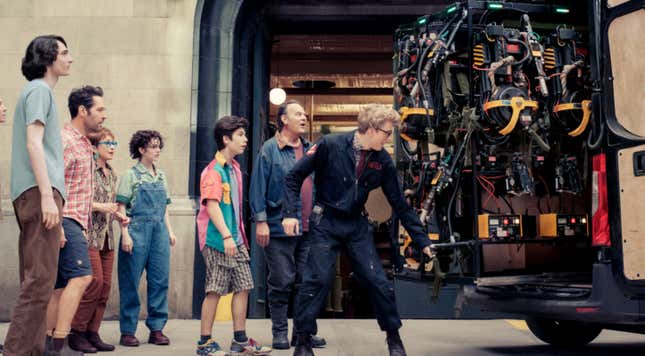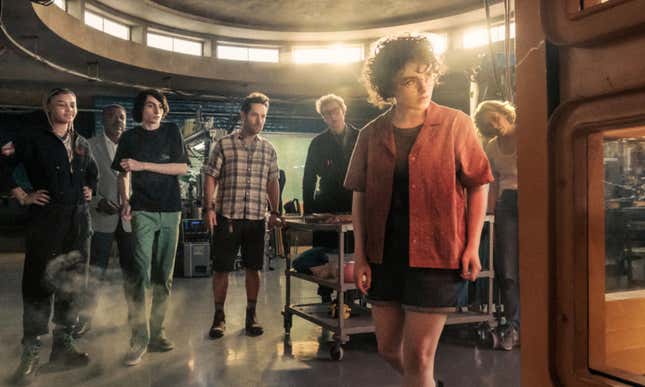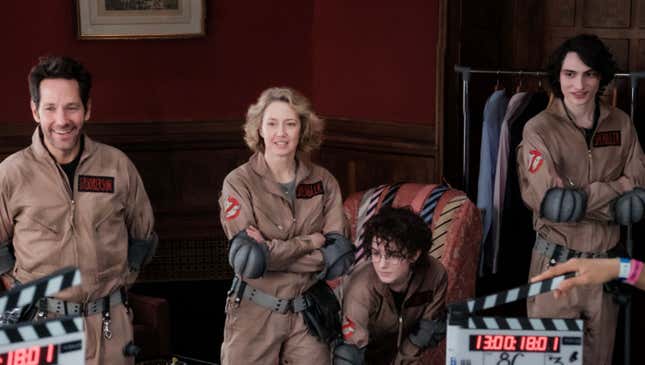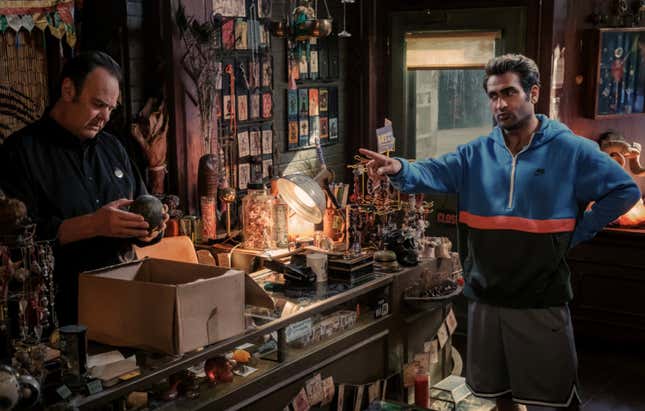Fans of Ghostbusters will find a lot to love about the latest film, Ghostbusters: Frozen Empire. It continues the story of Ghostbusters: Afterlife in a way that makes both films better in tandem. It also, in a series first, depicts characters discussing the great implications of ghosts existing. It shows us where Ghostbusting could go in the future, and even features a friendship between human and ghost. This, along with the story of New York City facing its greatest supernatural threat yet, is very much in the mold of Ghostbusters, just evolved ever so slightly.
Ernie Hudson on Winston’s Evolution and the Future of Ghostbusters
All that and more is partially because of Gil Kenan. Kenan, a lifelong Ghostbusters fan, co-wrote Afterlife with fellow fan and filmmaker Jason Reitman. For that earlier film, Reitman took the helm. This time, while they both wrote once again, it’s Kenan directing, which makes him the man with all the answers. Answers to questions like, where is Oscar, the son of original Ghostbusters character Dana? Will some of these new characters come back? And how important is it to get all of these things in there? Read Kenan’s explanations in io9’s interview below.
Germain Lussier, io9: One of the things I really like about Frozen Empire is how so much of it works because of everything you already earned in Ghostbusters: Afterlife. It made me wonder, what in this movie came out of developing or brainstorming Afterlife? Were there ideas you had then that simply couldn’t fit in and you held for a potential second movie?
Gil Kenan: We definitely wanted to set up the idea of the search for home for our new characters, the Spenglers, and obviously Gary Grooberson. And that search began with their dislocation at the start of Afterlife and the idea that maybe this farmhouse would be a way to solve a problem—a pragmatic problem—for Callie of, where do we ground this family that’s searching for something to cling to, some sense of permanence? So we had already kind of started through that process of developing that theme, thinking about the firehouse as a potential goal for this family that would solve a problem that was in need of solving and that they needed. Something to anchor to, in the same way that Ghostbusters fans were sort of clamoring for that return to the firehouse. That was a process that happened organically through the writing of Afterlife and it felt like a really natural setup for how this film could begin.
io9: But there’s always a danger that you don’t get to make another one, right? And obviously, you always hope you get to do a million of them. But how do you know what to hold back? This movie has so much in it that the fans are going to love it
Kenan: [laughs] You’re like “It doesn’t seem like there could be anything held back!”

io9: No, it feels like a good balance. I’m just wondering, how much do you have to restrain yourself? How much do you say, “I have to get this in now, just in case”?
Kenan: There were definitely elements that we made sort of prudent choices about because this is a big movie. It’s a big story and a lot of characters to be balancing throughout the film. And so I think it’s an expansive story. It felt like that was something we had to do because we’re bringing the story back to New York City. It’s a huge canvas. You want to live up to the scope of this place and fill it with spirits that feel like they’re worthy. And there were things we sort of had as instincts—like this idea of spirit-loaded objects. That was one we got really excited about in the conversations that Jason [Reitman] and I had after Afterlife and before writing this one. Those were conceptual excitements that we had that we knew we would place pins [in] to develop further. And we definitely have some of those that we are holding in our pockets, if we do get to make more of these.
io9: Awesome. Now, obviously, a movie needs a good story, good characters. But, I was also, again, very excited that this dug into so much other hardcore Ghostbusters stuff. Like we touch on the legacy, we touch on the bigger religious implications of ghosts, and then there are advancements of the technology. Was it important to you guys to touch on the kind of secondary things in addition to the story? Tell me a little bit about developing those things.
Kenan: That’s the richness of this universe, right? First of all, you’ve got to think back, this is now a 40-year tradition of storytelling. You have to imagine that the reason it has staying power for us as fans, I’m including myself in that number, is because when you watch those first couple of films—and I guess Afterlife as well? Even though I had a hand in it, I still watch it as a fan—you imagine that there is a sort of inner life beyond just the characters. There’s an inner life to the world of ghostbusting. They’re in a world where a proton pack can be built. You can sort of extrapolate in other directions. And that prospect’s really thrilling, actually.

It’s sort of what makes the idea of Ghostbusters existing at all so compelling. It’s such a simple hook that Dan Aykroyd had all those years ago. But it’s so rich because it suggests that you can use sort of homespun, modern tools to tap into the impossible. And so, yeah, exploring that in every direction in this film felt like it wasn’t just a requirement, it felt like it was an act of joy.
So every department—I have to tell you, I’ve never experienced working on a film where departments would come up and pitch ideas just out of sheer love for the films. They all wanted to do work that was not only in the best service of the story we’re telling, but that somehow fit into the larger continuum of these films. And that’s a really cool feeling as a director, because it feels like everyone is in it together as fans first and as film artists second.
io9: That’s so cool. I love that. I also love that this movie just drops us in on the action. They’re going at it, they’re Ghostbusters, but there’s obviously some story missing, of like them leaving Oklahoma, moving to New York, discovering the firehouse. Was any of that shot or in the script?
Kenan: We made a decisive choice as writers to leap forward two years in time. We actually had a shot that we considered doing at the end of Afterlife and never shot, that showed the family Subaru driving on the highway out of Oklahoma with a towed vehicle behind it covered in a tarp. And that tarp was flapping and you see sort of Ecto-1 behind it. But then, of course, we filmed that beautiful coda with Ernie Hudson’s Winston Zeddemore character bringing the Ecto-1 into the firehouse. That was our way of hooking it into the events that Frozen Empire was going to be delving into.

We wrote sketches of stories of what happened in those intervening years. And early on, Jason and I decided that those stories were not going to be essential to the story we were telling in Frozen Empire but they were interesting. And so we actually developed those as comic books. And they’re coming out in a week or two, and they’re really cool. And they fill in those two years from Oklahoma to the events of Frozen Empire.
io9: Okay great. Now, Wikipedia seems to think that, after the end credits scene in Afterlife, Dana [Sigourney Weaver] and Peter [Bill Murray] are married. Can you clear up? Are they actually married?
Kenan: If they are, it’s news to me.
io9: Okay, what about Dana’s son Oscar? There was speculation he might appear in one of these movies.
Kenan: We love Oscar. We have an idea of where he is. It’s possible he’ll show up in a future installment, but we don’t have that worked out yet.
io9: And what about the identity of Callie’s mom and Phoebe and Trevor’s dad? Is that purposely being held back, or is just something that doesn’t matter?
Kenan: You know, it’s part of their story, but so many of us have elements that help to shape who we are, that don’t actually matter in our day-to-day life. They are the elements that put us together but are not our current story or our current drama. It’s the same way with Phoebe’s dad and Callie’s mom. They are important building blocks to those characters, but they don’t figure in their day-to-day life. That’s something that I think a lot of audiences, for better or worse, can relate to. You know, sometimes your family is who’s around you right now and the people who care about you, the people who support you, the people who make a home for you, that’s what matters going forward. That’s how we approach the writing of these characters.

io9: Awesome. And this is my last thing, and I wish it wasn’t because I have a billion other questions, but you obviously love to populate a movie with great actors. But I found it interesting and exciting that specifically in Kumail Nanjiani and Patton Oswalt, they’re actors who were maybe on fan cast lists of potential new Ghostbuster teams. So how much did you look at that, and was any part of casting them a hint at maybe, just maybe, they’re part of this universe now going forward?
Kenan: Look, we’re simple guys. We just want the very, very best comedians in the world to join this franchise. And it was the same with James Acaster as with Kumail and with Patton. These guys are assassins, and they bring their A-game to this film. And Kumail specifically, I mean, they’re all phenomenal performers but Kumail was a part of the conversation of the building of this film. From very early stages we had an idea about who his character was going to be. He came in to have conversations with us as we were writing the script. And we really shaped this arc for him, with him. So, yeah, these are, as you can see from this film, we don’t shed characters lightly in this franchise [laughs]. So, I hope we’re lucky enough to make more. And I wouldn’t count any of them out.
Ghostbusters: Frozen Empire is now in theaters. Read our review here.
Want more io9 news? Check out when to expect the latest Marvel, Star Wars, and Star Trek releases, what’s next for the DC Universe on film and TV, and everything you need to know about the future of Doctor Who.






